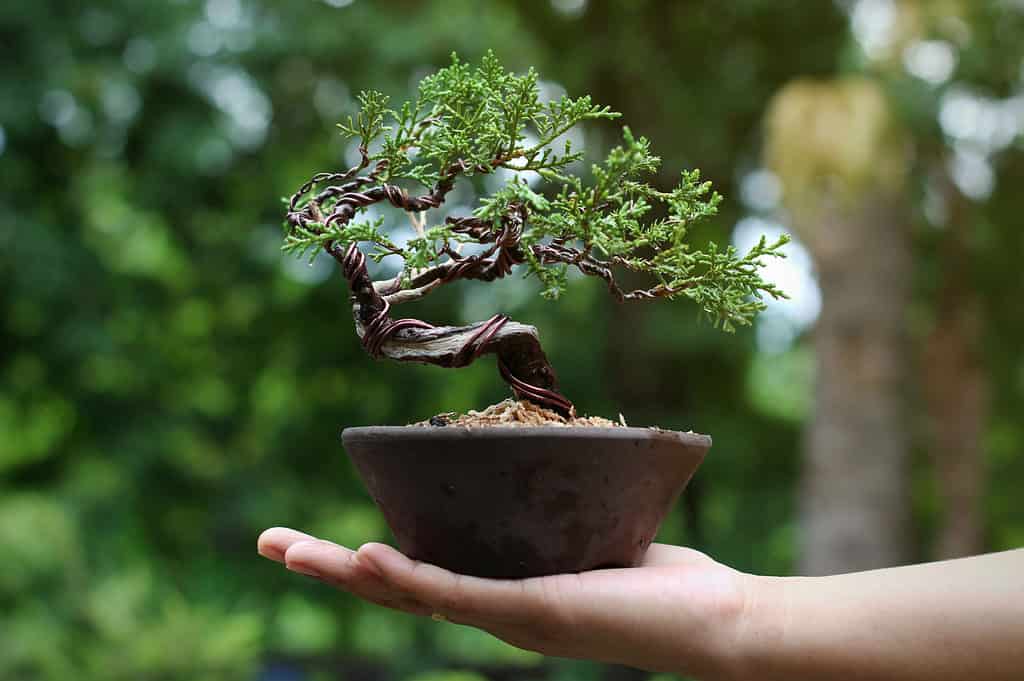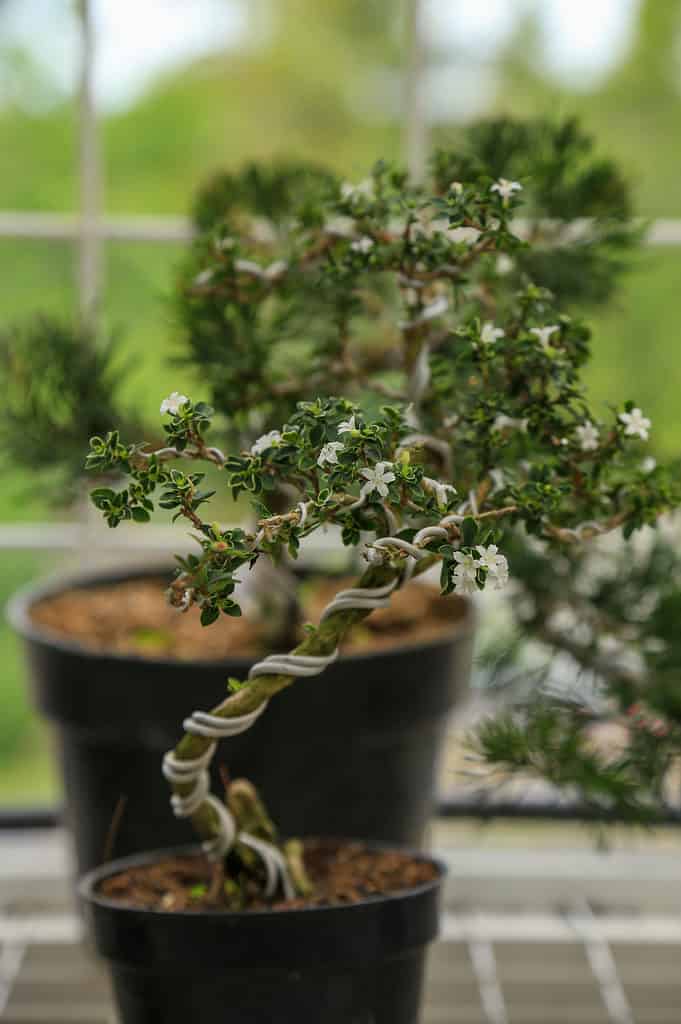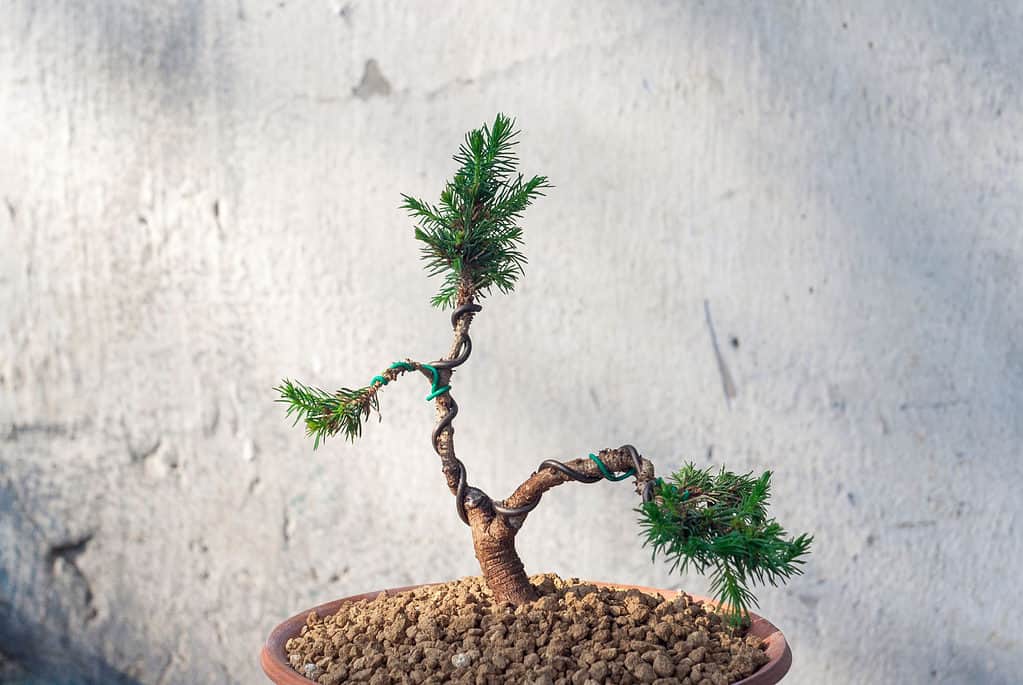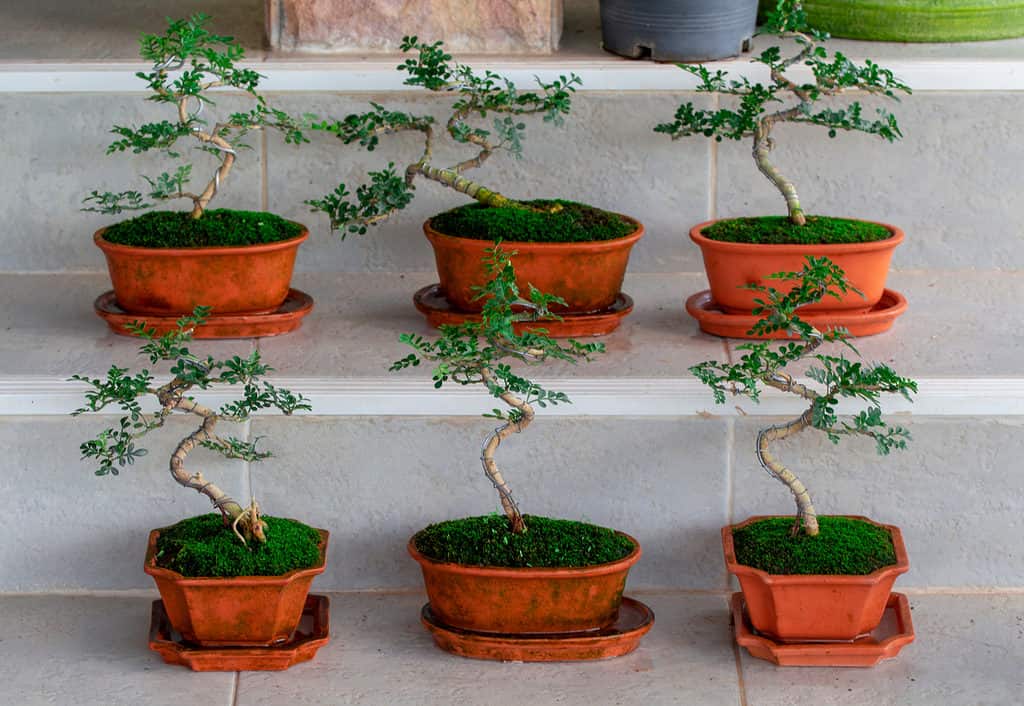If you have only just begun your research, you may not yet know the importance of wiring a Bonsai tree. Often one of the most daunting tasks when it comes to Bonsai tree care, wiring takes practice, patience, and proper timing. But why might you choose to wire a Bonsai tree in the first place and why is it inherent to the ancient art and practice of Bonsai tree maintenance?
In this article, we will go over everything you need to know about wiring Bonsai trees, including the types of wire best suited for the job. We’ll go over the time of year that you should consider wiring your specimen as well as how long you should wire your tree. Whether you’re an expert or a beginner when it comes to Bonsai trees, learning how to safely wire your specimen is a must! Let’s get started.
Wiring a Bonsai Tree: Why it Matters

©GrooTrai/Shutterstock.com
While wiring a Bonsai tree isn’t strictly necessary in order to take care of your new plant, it is part of the styling and shaping process. There are a number of different Bonsai tree styles for you to consider if you are attempting to shape your tree for the first time, but most of these styles cannot be achieved without wiring.
The act of wiring a Bonsai tree is a delicate balance of bending branches to suit your design, but in a careful manner so that you don’t harm your specimen. By wrapping wire around the sturdy branches of your tree, you can carefully manipulate them to achieve a desired curvature or artistic style. However, none of this process is designed to happen overnight and there are many factors to consider before starting your wiring journey!
When Should You Wire a Bonsai Tree?

©qSPOoKYp/Shutterstock.com
Both time of year and the health of your specimen greatly affect when you should wire your Bonsai tree. The overall age of your tree also matters, but there isn’t a specific age that you need to wait for. It has more to do with how healthy and established your tree is in its container, as well as the overall health of its root system and branches.
Many Bonsai tree experts don’t begin wiring or styling their tree until they’ve owned it for 2-3 years. Again, it depends on the health of your Bonsai tree more than a specific calendar date. Your tree needs to be in peak health before it can handle being heavily manipulated! You should also time your wiring so that it doesn’t overlap with a year that you plan on repotting or heavily pruning your tree.
Time of year can also matter when it comes to wiring, though you can technically start the wiring process during any season. However, many experts recommend wiring in the wintertime. This is a time of year when most trees will be dormant and also when many trees will have already shed their leaves.
If you choose to wire your tree in the spring or summer, keep in mind that you’ll need to watch the wire carefully. Some trees grow fast enough that the wrapped wire will cut into your branches in a matter of weeks!
What Wire is Best for Bonsai Tree Styling?

©hidan.hid/Shutterstock.com
It’s important to note that certain wire types and gauges of wire are best for Bonsai tree shaping and styling. You don’t want to use a wire that is too thick, nor should you use something too thin. Plus, certain types of Bonsai trees respond better to some materials than others. Here are the types of wires used in Bonsai tree shaping, as well as the thicknesses you should look for.
Aluminum Wire
Recommended as the best wire for beginning Bonsai tree artists, aluminum is soft and easy to manipulate. This is the perfect metal type when it comes to working with softwood trees as well as most deciduous tree varieties. Plus, it is readily available in hardware stores and garden centers for a fair price. Choosing a few different sizes of aluminum wire ranging from 1-4mm thick is a good place to start.
Copper Wire
Stronger and thicker compared to aluminum wire, copper is a must if you have a conifer, pine, or another sturdy tree type. Given that this wire is more expensive and more difficult to work with, you may not want to start with this type if you are a beginner. However, the reliable strength of this wire type means that you can better shape any Bonsai trees that have harder or more resilient wood without losing your design!
Don’t Forget the Raffia!
While it isn’t exactly wire, you may want to consider purchasing raffia or another type of natural fiber to aid in your Bonsai tree wrapping process. By soaking these fibers and wrapping your tree’s branches with them before you begin wiring, you can better protect your Bonsai tree during this invasive process. While it may not save your branches from harm if you leave your wires on too long, it’s certainly a helpful barrier and relatively inexpensive!
Methods of Bonsai Tree Wiring

©pjatnica/Shutterstock.com
While practice is key to properly wiring your Bonsai trees, there are a few different methods to consider. Here are the different ways that you can wire your specimen, largely based on the type of tree you have and how you are hoping to shape it.
Single-Wiring
As the name implies, single-wiring is the act of wiring a single branch independently from all of the others. Perhaps you have a wayward branch that isn’t curving like the rest of your branches. Or maybe you want to train a single branch to make a statement. Regardless, single-wiring can help if you don’t need all of your branches to twist and turn identically to one another.
Double-Wiring
Compared to single-wiring, double-wiring involves wrapping two nearby branches in a similar way. In fact, you’ll still only use one piece of wire to accomplish this, wrapping it around one branch before attaching the wire to a nearby branch. This helps achieve a uniformity and cohesive appearance for your tree, frequently used in certain Bonsai tree styles.
Guy-Wiring
If you are attempting to lower or manipulate a branch located separately from the others, you may consider a guy-wiring method. This process is useful if you are dealing with particularly thick or delicate branches. Guy-wiring involves attaching a branch to a wire and anchoring that wire to the base or trunk of the tree or container that your tree is in. This method is fairly simple given the fact that you don’t need to fully wrap your branch to achieve a bent or downward design.
How to Wire a Bonsai Tree

©Mick Harper/Shutterstock.com
Now that you know a bit about Bonsai tree wiring and care, here’s how to properly and safely wire your specimen, step by step.
- Identify the branch(es) that you wish to wire. Determine how thick these branches are and choose a wire that is less than half of the branch’s thickness. You will likely need more than one wire size, depending on how many offshoots or twigs your branch has.
- Wrap the wire around your tree at an angle. 45 degrees is often appropriate for the safe and careful wiring of your specimen. Spiral the wire around your branch evenly.
- Add other wire sizes and wrap in tandem with your initial wire. If you have a branch with smaller branches attached to it, you’ll have to wrap these thinner twigs with smaller wires. Wrap the smaller-gauge wires alongside your first wire. Continue the same spiral pattern down the entire length of the branch.
- Cut your wires once your branch is wrapped. Make sure that all wires are cut and in their proper places before attempting to manipulate them.
- Using your thumbs, gently bend your branches from the inside edge. Be sure to support your branch from the outside edges during this process and take your time!
- Once bent into position, leave your tree alone! The constant manipulation of your tree will likely do more harm than good. Once you are satisfied with your wire styling, it’s time to let your tree be.
What About Guy-Wiring?
If you are attempting to guy-wire your Bonsai tree, the process is much the same. However, you’ll likely not need to wrap the entire branch. The most important part of the guy-wiring process is the anchoring of your wire to either the pot or roots of your tree. Slowly attach your guy-wire to the base of your specimen, taking special care that no branches creak or snap!
Tips for Wiring Your Bonsai Tree

©K Stocker/Shutterstock.com
The process of wiring any Bonsai tree takes time, care, and practice more than anything else. However, here are a few tips to consider and keep in mind if you are nervous about this process!
Know Your Species
Before you begin wiring any type of Bonsai tree, you need to know what species and type of tree that you have. Given the fact that conifers will need a heavier-duty wire compared to deciduous trees, knowing your species is key to a successful wiring attempt. Likewise, knowing the type of tree you have will give you a good idea as to how malleable the wood is to begin with. Plus, this will also give you some insight as to how your foliage will be before, during, and after the wiring is complete!
Know Your Growth Seasons
Just like you should know what species your tree is, you should also know when your tree is actively growing. While most indoor Bonsai trees grow year-round, outdoor Bonsai trees have both dormant and active growth seasons. Timing your wiring appropriately during the year is key if you want to avoid damage and fully set your design.
Many types of trees grow best during the spring and summer, making this a dangerous time to wire your specimen. The last thing you need is for your branches to thicken and grow while they are wired. The wire can easily cut into your branches and leave unnatural scars!
Watch Closely for Damage
Even if you choose to wire your Bonsai tree during the wintertime, you should still pay special attention to your specimen while it is wired. Damage to your tree can happen quickly and without warning. However, it is all avoidable if you watch your wired branches carefully. While many Bonsai tree experts recommend leaving your branches wired for 1-5 months, it all depends on the species of tree as well as the time of year when you should remove your wires. If you see your tree taking damage from the wiring process, remove them immediately.
Practice Makes Perfect!
It’s unlikely that you will wire your very first Bonsai tree perfectly. Every single Bonsai tree is unique, capable of growing at different rates and adjusting to wiring in a variety of ways. That’s why it’s important to take your time when styling your Bonsai tree, as mistakes are common. So long as you keep your tree healthy and happy, you can always wire your specimen again at a later date! It’s never too late to try again when it comes to Bonsai tree shaping and styling.
Up Next:
- The Best Soil for Bonsai Trees
- How to Properly Place a Bonsai Tree
- Bonsai Styles: Everything You Need to Know
The post Wiring a Bonsai Tree: Everything You Need to Know appeared first on AZ Animals.
from Animal News, Facts, Rankings, and More! - AZ Animals https://ift.tt/90ExORV